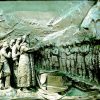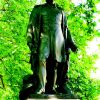Sir John Franklin was introduced to a career in the navy and a lifetime of adventure by his older cousin, Captain Matthew Flinders. Franklin rose to become Knight Commander of the Hanoverian Guelphic Order, Knight of the Greek Order of the Redeemer, Captain in His Majesty’s Royal Navy, Lieutenant Governor for the island of Van Diemen’s Land, Doctor of Civil Law of Oxford University, Fellow of The Royal Society, a Gold Medallist of the Geographical Society of Paris and a significant author – and he is acclaimed as the explorer who went in search of the Northwest Passage and who mapped almost two-thirds of the northern coastline of Canada.
It is almost certain that Governor John Franklin was among the first of a handful of people to be named in the streets of Adelaide. Moreover, it is likely that after the Street Naming Committee paid the required deference to royalty and given cult status to both George Grote and Edward Gibbon Wakefield, both Franklin and Flinders were probably next to be considered. They were cousins, they served in the war against France, they were sailors, they were explorers, they died in unforeseen and tragic circumstances and they were chosen for street names almost in the same breath.
Franklin and Flinders were clearly thought of as a pair because of their adventurous maritime documentation and discovery of the coast of South Australia. This conclusion is based on the assumption that the Committee worked systematically from the centre of Victoria Square. The pattern of pairing streets like this, while not always so neatly applied throughout the naming process, was nevertheless a feature of some of the other attributions which were to follow.
Sir John Franklin, as he had become by 1837, had only just taken up the governorship of Van Diemen’s Land earlier in the year when Franklin Street was named. His case for inclusion in Adelaide’s streets was all the more convincing because Sir John Jeffcott and John Barton Hack were on the Street Naming Committee and they had both come out to Australia on the HMS Isabella with him. His eminence and recent promotion to Knight Commander of the Hanoverian Guelphic Order (in 1836) echoed in their minds.
By 1834 Franklin was held with such acclaim by the authorities in London that he came under consideration as a potential Governor of South Australia. However, when the South Australian Association formed at the end of 1833, members voted for their Chairman, Colonel C.J. Napier instead, not realising that Thomas Spring Rice, Secretary of State for War and the Colonies, had already pencilled in John Franklin.
In 1829, Franklin and Sir William Edward Parry were knighted for their services to Arctic exploration. They became good friends, which helps to explain why Sir John and Lady Franklin later became involved in philanthropic endeavours such as penal reform and the emigration of young women; Parry was heavily involved with the London Emigration Committee and, by association, the Colonial Church Society. The proponents of this movement were driven by a desire to equalise the sexes in Australia in what had become male-dominated communities in the Australian penal colonies.
Sir John Franklin led an audacious and ultimately fateful lifestyle from the moment he entered the navy at age 14, in October 1800. He was born in April 1786 in the village of Spilsby, Lincolnshire, not far from cousin Matthew Flinders’ home in Donington. He was the fifth son and ninth child of twelve to Willingham Franklin and his wife Hannah, (nee Weekes).
Sir John Franklin was educated at St Ives and Louth grammar schools. His parents expected him to go into the church. But he had a passion for the sea, not shared by his father, who allowed him to go on a merchant ship voyage to Lisbon so that he might be deterred by the hardships associated with navy life. Rather than discourage the young John, it only excited him further and he entered the navy permanently as an ordinary seaman in October 1800 under Captain John Lawford aboard the HMS Polyphemus.
Franklin saw his first maritime service at the Battle of Copenhagen in April 1801. He then joined Matthew Flinders as one of eight midshipmen on the HMS Investigator as it sailed eastward along the ‘unknown coast’ of South Australia.
By 1805 the young sailor Franklin was thrust into the main game on the high seas as the signal midshipman on Captain John Hindmarsh’s first ship, HMS Bellerophon. Promoted to Lieutenant in February 1808, Franklin afterwards escorted the Royal Family of Portugal from Lisbon to South America.
By 1819 Franklin had begun the first of his several notorious adventures in the northernmost extremities of the North American continent and the Arctic. This expedition lasted for three years and was conducted under the most trying of circumstances. The men were forced to trudge some 8,850 kilometres (5,500 miles) through the ice-bound landscape and suffered unimaginable hunger.
In 1823 Franklin published a three-volume account of the whole sordid event, which was received with much acclaim. On his return he was both surprised and pleased to find he had been promoted to Commander. Soon after he was further promoted to Post Captain and coincidently elected as a Fellow of The Royal Society.
In 1823 he married Eleanor Porden – a minor romantic poet of the day, a close friend of Jane Griffin and a member of polite society. She delivered Franklin a daughter in 1824 who they named Eleanor Isabella. The little girl survived, but unfortunately John’s wife came down with tuberculosis, delaying his second trip to the Arctic Circle, which was planned from some time in 1823. Eleanor knew she was dying but insisted that John embark on the voyage. The day after he departed in 1825, she succumbed. He was away for the next two years and seven months.
Equipped by the Admiralty and The Royal Society, the party departed on 21 February, venturing towards the Arctic Ocean by way of the Mackenzie River. This expedition was considerably more successful and the geographical and scientific reports were of great value. Oxford University showered Franklin with praise and awarded him an Honorary Doctorate of Civil Law.
In 1828 Franklin married his late wife’s close friend, Jane Griffin. When he was knighted by George IV in 1829, she became Lady Franklin. There were no children to this marriage.
He took command of HMS Rainbow for a three-year commission in the Mediterranean. Greece was embroiled in a war of independence during this period and as a result of Captain Franklin’s naval support he was awarded one of that country’s highest honours, Knight of the Greek Order of the Redeemer.
On his return to England Franklin was received by King William IV in 1836 and appointed Knight Commander of the Hanoverian Guelphic Order.
Sir John Franklin accepted the position of Governor of Tasmania between 1837 and 1843. Arriving into Hobart in January 1837, he set about introducing reform. He was recalled unexpectedly by Colonial Secretary Edward Geoffrey Stanley after John Montagu, his Colonial Secretary in Tasmania, had returned to England, claiming to good effect that he had been unfairly dismissed by the Governor. Franklin sacked Montagu because he had written him an insulting letter, in which he cast doubts and aspersions about the Governor’s character and accused him of allowing Lady Franklin too much influence over policy in the colony.
In 1843 Sir John and Lady Franklin returned to Britain embarrassed and insulted by the recall. Sir John was unable to convince Secretary Stanley that he had been unfairly demonised and set about explaining the circumstances in a detailed publication in 1845.
In a desperate move to rebuild his name, Franklin sought redemption through the Admiralty. At age 59, he received official instructions to depart England on 5 May 1845 to again try to find the Northwest Passage in the Arctic Circle, never to be seen alive again. They had three years’ worth of supplies, including thousands of cans of food which unfortunately had been contaminated by poor lead seams along the joints of the metal.
Sir John Franklin died in the ice in 1847, somewhere adjacent to the coast on King William Island.
Despite protracted and repeated efforts by both British and American rescue teams to find the party for more than a decade, the expenditure of thousands of pounds by Lady Franklin and others, and a raging controversy about the likelihood that some of the party had been reduced to cannibalism, the attempt to find the Northwest Passage was a resounding failure. With great certainty it has since been established Franklin died two years into the three-year expedition. The remainder died a year later, wrought with starvation, tuberculosis, hypothermia, lead poisoning, scurvy and exposure.
In 1859, Francis Leopold McClintock found a cairn which confirmed Franklin’s death on 11 June 1847 and a number of skeletal remains with bone cuts suggestive of the most abhorrent closure.







Comments